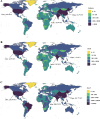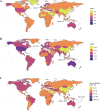The global burden and attributable risk factor analysis of acute myeloid leukemia in 195 countries and territories from 1990 to 2017: estimates based on the global burden of disease study 2017
- PMID: 32513227
- PMCID: PMC7282046
- DOI: 10.1186/s13045-020-00908-z
The global burden and attributable risk factor analysis of acute myeloid leukemia in 195 countries and territories from 1990 to 2017: estimates based on the global burden of disease study 2017
Abstract
Background: Acute myeloid leukemia (AML) is a common leukemia subtype and has a poor prognosis. The risk of AML is highly related to age. In the context of population aging, a comprehensive report presenting epidemiological trends of AML is evaluable for policy-marker to allocate healthy resources.
Methods: This study was based on the Global Burden of Disease 2017 database. We analyzed the change trends of incidence rate, death rate, and disability-adjusted life year (DALY) rate by calculating the corresponding estimated annual percentage change (EAPC) values. Besides, we investigated the influence of social development degree on AML's epidemiological trends and potential risk factors for AML-related mortality.
Results: From 1990 to 2017, the incidence of AML gradually increased in the globe. Males and elder people had a higher possibility to develop AML. Developed countries tended to have higher age-standardized incidence rate and death rate than developing regions. Smoking, high body mass index, occupational exposure to benzene, and formaldehyde were the main risk factors for AML-related mortality. Notably, the contribution ratio of exposure to carcinogens was significantly increased in the low social-demographic index (SDI) region than in the high SDI region.
Conclusion: Generally, the burden of AML became heavier during the past 28 years which might need more health resources to resolve this population aging-associated problem. In the present stage, developed countries with high SDI had the most AML incidences and deaths. At the same time, developing countries with middle- or low-middle SDI also need to take actions to relieve rapidly increased AML burden.
Keywords: Acute myeloid leukemia; Cancer epidemiology; Cancer statistics; Global burden disease; Population aging.
Conflict of interest statement
The authors declare that they have no competing interests.
Figures







References
-
- Siegel RL, Miller KD, Jemal A. Cancer statistics, 2017. CA Cancer J Clin. 2017;67:7–30. - PubMed
-
- Shallis RM, Wang R, Davidoff A, Ma X, Zeidan AM. Epidemiology of acute myeloid leukemia: recent progress and enduring challenges. Blood Rev. 2019;36:70–87. - PubMed
-
- Lane SW, Gilliland DG. Leukemia stem cells. Semin Cancer Biol. 2010;20:71–76. - PubMed
Publication types
MeSH terms
Substances
LinkOut - more resources
Full Text Sources
Medical
Miscellaneous

